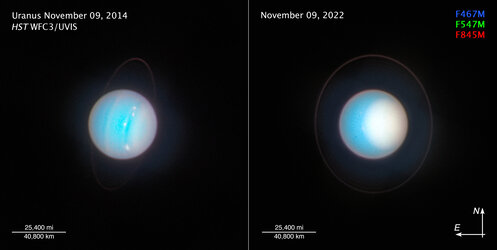

Hubble and New Horizons view of Uranus
In this image, two three-dimensional shapes (top) of Uranus are compared to the actual views of the planet from the NASA/ESA Hubble Space Telescope (bottom left) and NASA’s New Horizon’s spacecraft (bottom right). These two missions recently simultaneously observed the gas giant, comparing high-resolution images from Hubble to the smaller view from New Horizons. This combined perspective will help researchers learn more about what to expect while imaging planets around other stars with future observatories.
By knowing the “truth” of what the planet looks like from Hubble, researchers are able to confirm or refute what is interpreted from the New Horizons data. In this study, the planet was viewed by Hubble when it was at full phase, when the entire sunlit side of the planet was visible. By New Horizons, Uranus was viewed at partial and high phase, when only a portion of the planet is illuminated by the Sun.
Researchers can only directly image exoplanets at ‘partial phases,’ when only a portion of the planet is illuminated by their star.
In the New Horizons image, Uranus was dimmer than predicted at partial and high phase angles, showing that the atmosphere reflects light differently at partial phase, as seen by New Horizons, than it does at full phase, as seen by Hubble.
[Image description: A four-panel image. The top two panels are diagrams of Uranus – spheres with gridlines going longitudinally and latitudinally. On the top left, the view from Hubble, the southern pole of the planet faces 3 o’clock. On the top right, the view from New Horizons, the southern pole faces 10 o’clock. The bottom left panel is Hubble’s actual view of Uranus – the planet is a light blue sphere, with a white circle covering the right half of the planet (the southern pole). The bottom right panel is the actual view of Uranus from New Horizons. The planet appears as a tiny white dot.]





